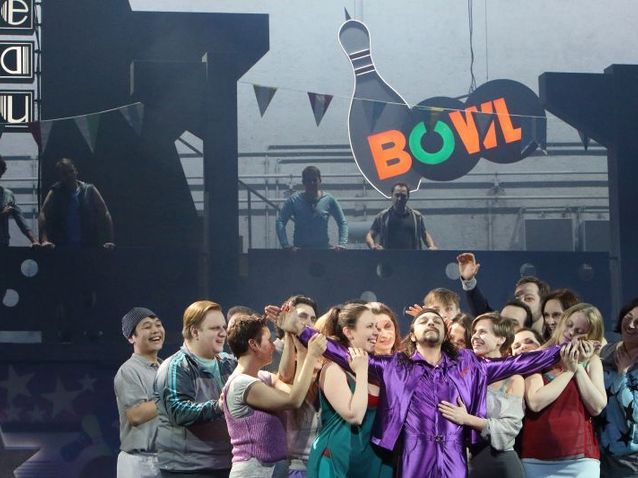 © DR
© DR
Conductor Oksana Lyniv has entered the pit. An expectant silence has fallen over the audience. Suddenly, a ragtag group of long-haired men steps onstage. One introduces himself as the manager of the band Ciel. They’ve lost their lead singer, Ory. Have we seen him?
So begins our Rossini-led romp through the 1980s. Instead of hoop skirts: leg warmers; instead of a chateau: a bowling alley. The captain of the women’s bowling team, Adele, is a pious and melancholy sort who has sworn off love. But when Ory arrives wearing a shiny purple track suit and performing miracles (in the form of both faith healings and improbable bowling strikes), she is quickly persuaded to forget her oath.
The updated setting should be the perfect playground for the young members of the Bayerische Staatsoper’s Opernstudio. But its charms are often undermined by director Marcus Rosenmüller’s insistence on packing the staging with slapstick gags. Rossini’s opera has plenty of situational comedy; it doesn’t also need Ory smashing Isolier’s head into walls and Raimbaud feeling up girls’ butts. These contrived bits of staging are sloppily executed and seem to break the singers’ focus, with the cast sometimes scrambling to go through the right moves onstage rather than inhabiting their characters.
The best silly touches serve the plot: the act I scene between Isolier and Ory begins with Ory in the shower, which explains why Isolier doesn’t immediately recognize him. (They are speaking through the wall of the shower stall.) A similar device would have been handy in act II, where it’s very unclear when Adele realizes that the “nun” she is sheltering is in fact Ory. In an opera plot based around disguises, it’s important that we be able to tell who recognizes whom at any given moment. Some directorial choices simply add to the confusion: The “casks of wine” Raimbaud brings back from his mission are chorus girls, whose blood he and the other men drink. I couldn’t decide whether vampirism was supposed to be a deep comment on male sexuality or just a portrayal of a kinky 80s fad I’ve never heard of.
Members of the Opernstudio are well-cast in the opera’s demanding roles. Soprano Anna Rajah dexterously managed Adele’s coloratura sections, though she didn’t show off much with them. Instead, she wowed with her ability to let high notes float and bloom and with her ringing upper range. Her character swung back and forth between prudish determination and lustful excitement; she played both well, though the transitions between the two could seem sudden and unmotivated. As Ragonde, Rachael Wilson revealed a lush mezzo voice that contrasted nicely with Rajah’s sharper sound. She, at least, was unambiguous about what she wanted: a man. But she may have gotten more than she bargained for in the particularly vampiric Raimbaud, sung by the solid but insufficiently heroic-sounding bass Evgenij Kachurovsky.
Leonard Bernad, singing the Gouverneur, was announced as sick. There was a sometimes-unpleasant gravelly quality in his bass voice that reflected his illness, but he still demonstrated his expressive ability and pulled off some nicely resonant low notes. Tenor Petr Nekoranec, on the other hand, shone on his high notes, singing the opera’s title role with technical skill and obvious relish. However, he didn’t quite have the charisma to be expected from as successful a womanizer as Ory is reputed to be. Perhaps that’s because the staging got in his way, or perhaps it’s because his romantic rival Isolier outshone him. Marzia Marzo sang the trouser role in an effortless-sounding mezzo voice and acted with just the right mix of manly swagger and lovesick pining. She seemed the most natural onstage of all the cast, throwing herself into even the most ridiculous bits of staging with confidence. Her facial expression when she realized that her madcap scene with Ory and Adele was on the verge of become a threesome was priceless.
Both the male and female choruses had a lot to do in this opera, singing- and acting-wise. The Staatsoper’s Extrachor sounded good, with well-blended voices and a nice variety of textures, and acted convincingly. Their blocking could get a tad messy, but that’s to be expected when you put fourteen men in comically large nuns’ habits on the small stage of the Cuvilliés Theater. The Staatsorchester, led by Oksana Lyniv, started off well with a lively, precise overture. The playing remained crisp and well-balanced (both between sections and with the singers) throughout. However, the tempi dragged at times. The Gouverneur’s first-act aria was funereally slow, and even the opera’s quickest sections never reached the ideal hectic patter pace.
The cast of this Comte Ory acquitted themselves well, and it’s certainly worth taking this opportunity to see a fun, rarely performed Rossini comedy. But between the slow musical pace and the awkward bits of staging, this performance was missing the spark of energy that would elevate it from good to excellent.
by Ilana Walder-Biesanz
Le Comte Ory (Opernstudio 2015)
the 20 of April, 2015 | Print
Comments